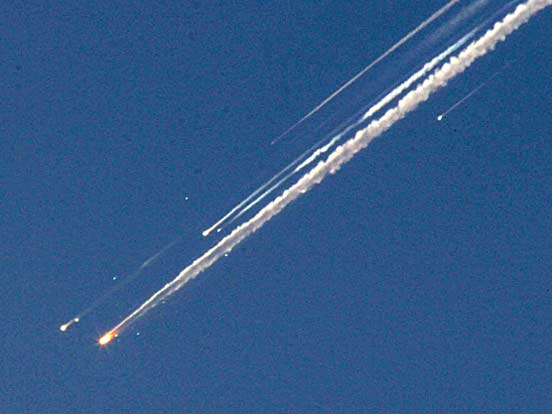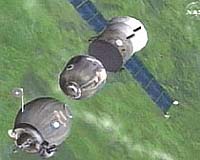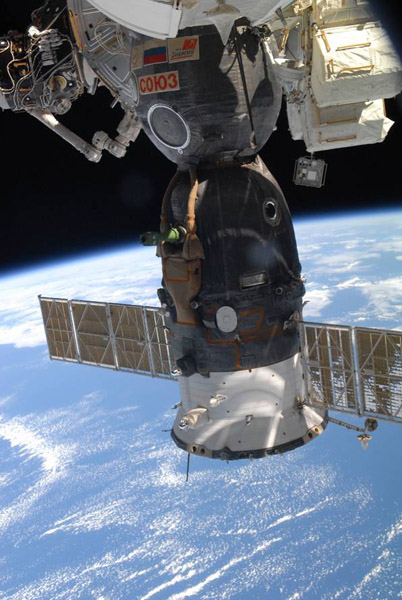More astronauts have been killed during the return from the mission than at any other stage. So many things can go wrong during atmospheric entry, and almost all of them can be fatal.

Anyone who has watched a space shuttle take off will never be able to forget the incredible experience. The roar of the jets emitted from the booster rockets shakes the ears with a tremendous noise. The ground trembles under your feet. The mighty engines shine with a blinding white light, taking the spaceship into the unknown - and hundreds of space enthusiasts follow the shuttle with shining eyes.
Returning to Earth is a completely different story. As the spacecraft races toward Earth at tens of kilometers per second, the only ones there to enjoy this dubious experience are the astronauts inside. No one follows the spaceship with bright eyes. Even the communication with the control room is cut off.
And ironically, as we witnessed In the space shuttle Columbia disaster Which also affected us Israelis, precisely the return to the atmosphere is the most difficult and dangerous stage of flight into space. There is no doubt that the take-off and the flight itself can also be dangerous, but the facts speak for themselves: more astronauts have been killed during the return from the mission than at any other stage. So many things can go wrong during atmospheric entry, and almost all of them can be fatal.
When rocket propulsion was still in its infancy and space travel seemed more like a dream than a reality, few gave any thought to the return to Earth phase. But in the XNUMXs, the Americans and the Soviets already had nuclear bombs, and the Cold War began to gain momentum. The most pressing need was to find an efficient method to bring the atomic bombs to their destination.

Intercontinental ballistic missiles were a perfect solution in every respect, and the Russians were the first to reach the finish line. The R-7 intercontinental missile was placed on the launch pad, and at the end of 1957 it took off for its maiden flight. It soared into space, successfully traveled a distance of several thousand kilometers and then... completely burned up upon entering the atmosphere.
The Soviet scientists were very surprised. They designed the R-7 so that its nose would be as narrow and aerodynamic as possible to avoid friction with the air molecules. If there is no friction, then where did all this heat come from? They didn't know it, but their colleagues in the United States had already solved this riddle long ago.
Researchers Julian Allen and Alfred Eggers discovered back in 1951 that friction is not the reason for the heating of the air around the rocket body. Waves move through the air at the speed of sound. This is the maximum speed at which information can travel through the air. If the missile or spacecraft is moving through the atmosphere at a speed that exceeds the speed of sound, the gas molecules of the air are not enough to 'evade' the missile. The information about the approaching missile can move at most at the speed of sound, but the missile itself moves faster. As a result, the gas molecules are compressed into each other. A 'shock wave' is created, which is an area where the density of the gas changes sharply and suddenly: from free and regular gas to ultra-compressed gas.
The sudden change in gas density causes its temperature to rise sharply as well. This is why R-7 burns up upon entering the atmosphere, even though it was designed to avoid friction: friction has nothing to do with a shock wave! In fact, the opposite is true: the higher the drag - that is, the more friction there is - the colder the missile will be.
As the pair of American researchers discovered, in the absence of friction the hot gases that are formed in the nose area slide over the surface of the missile's body and heat it up. If, on the other hand, the sharp, frictionless nose is replaced by a blunt and very un-aerodynamic nose, the air gets 'stuck' in the nose. An insulation layer is formed that prevents the hot gases from flowing backwards and sliding over the surface of the missile's body.
This surprising discovery was kept by the Americans as a military secret, but the Soviet scientists soon discovered it themselves. The nose of the R-7 was changed from a long narrow cone to a bulbous and blunt cone - that is, rounded like the end of a potato, for example. The missile was successfully launched on the next test flight.
When the two superpowers began the space race, the protection of the astronauts during the return from space became of paramount importance. The noses of ballistic missiles can be shielded with thick, heavy layers of heat-insulating materials, but this approach has not been practical in spacecraft.
Robert Goddard, another one of the space pioneers of the twenties and thirties, noticed an interesting phenomenon. Meteors from outer space penetrate the atmosphere at speeds of thousands of kilometers per hour, just like ballistic missiles and spacecraft. The meteor ignites and shines brightly as it falls. Still, chemical tests on meteorites reveal that the scorching heat penetrates at most only a few centimeters below the surface.
This intriguing observation led Goddard to a fascinating conclusion. The process that occurs on the surface of the meteor during flight is called 'Evaporation' (in English, Ablation). The intense heat crumbles the fragile surface and vaporizes them. The hot gases are emitted from the falling meteor and take the heat from it with them. This process can be compared to the sweating of the human body, and how the evaporating sweat cools us.
The engineers were quick to imitate nature, and the protection in the first spaceships was based entirely on vapor. But this did not solve all the problems of entering the atmosphere.
On the twenty-fourth of April 1967, the spacecraft was Soyuz 1 The launch pad is placed on the Baikonur base in Kazakhstan. Inside it was a single crew member, the cosmonaut Vladimir Komarov. It was supposed to be a particularly celebratory mission, as it was the first night launch in history.
But behind the scenes there were celebrations of a different kind. Serious disagreements emerged between the spacecraft engineers and the space program managers. In early experiments, hundreds of faults were discovered in the various systems, some of them critical and extremely dangerous faults. Many engineers thought that Soyuz 1 was simply not fit to go into space.

The political ranks exerted heavy pressure to approve the launch on the scheduled date. Two years had passed since the Soviet Union put a man into orbit around the Earth, and the nation's honor was at stake. There is at least one testimony that a member of the Politburo threatened to 'tear the ranks off the chest and shoulders' of the project manager if Soyuz 1 did not take off as planned.
Political pressure prevailed over engineering considerations, and Soyuz 1 took off into space with Komarov on board. Within a few hours the malfunctions in the spaceship started popping up one after another. The left solar collector failed to deploy properly, and as a result interfered with the operation of the spacecraft's stabilization systems. The spacecraft rolled around the Earth almost uncontrollably.
On the ground it was clear that Soyuz 1 was a resounding failure. The possibility of launching Soyuz 2 for a rescue operation following her sister was considered, but the idea was rejected outright. The official reason was rain at the launch site, but it was likely clear to everyone at Baikonur that the technical condition of Soyuz 2 was no better than that of its sister.
From the control room, Komarov was ordered to start expedited processes to return to Earth. Despite all the failures and problems, it seemed that the spacecraft had a good chance of landing safely on the ground - although about fifty kilometers from the planned landing place.
The rescue team was called to the new landing area, and from a distance they located the spacecraft on the ground with the parachute deployed next to it. At that moment, the rescuers saw the spacecraft's braking rockets go into action. This was a very bad sign, since the containment rockets are supposed to operate, in principle, while the spacecraft is still in the air.
When the rescue team approached, the sad truth became clear - Soyuz 1 was completely broken and crushed. In a later investigation it was determined that the spacecraft managed to penetrate into the atmosphere safely, but then the main parachute failed and did not open properly. The spare parachute opened - but its wires got tangled in each other. Soyuz 1 crashed to the ground and Komarov was killed on the spot - the first person to die on the altar of the conquest of space. Rumor has it that Komarov cursed the Soyuz flight controllers and engineers all the way down.
This did not end the troubles of the Soyuz program. In June 1971, the Soyuz 11 spacecraft returned to Earth. It dropped more or less at its intended landing point, and ground crews rushed to help the three cosmonauts out of it. They opened the door of the spaceship, and to their horror found all the crew members dead.
The investigation revealed that explosive charges that were supposed to detonate one after the other to disconnect the service module from the spacecraft before landing all exploded at the same time. A hole opened in the spaceship, and the air escaped through it. The three cosmonauts were strapped to their chairs, without spacesuits. In forty seconds it was all over.
The Americans preferred to land their spaceships in ocean waters, rather than on land, for practical reasons. In ground landings, special rockets must be used that slow down the spaceship just before hitting the ground. Landing in the soft water eliminates the need for these rockets, therefore greatly simplifying the engineering design. The Soviets would also have been very happy to avoid the rockets, but since Russia is mostly land-locked, they had no choice. They would have to land their spaceships on solid ground, despite all the dangers involved.
By the way, the only time a Soviet spacecraft landed in water was in 1976. A sudden blizzard diverted Soyuz 23 from its planned arrival point, and the spacecraft crashed into a frozen lake. The parachute filled with water, and the surprised crew members suddenly turned from cosmonauts into 'divers'. Fortunately, the rescue forces managed to reach the place in time, and successfully pulled the spaceship out of the lake.
The American space shuttle revolutionized the way spacecraft return to Earth. The ballistic fall was replaced by a long and slow soar, at the end of which the shuttle lands gently on a runway - just like a normal airplane.
The long lay-out means that the bottom of the shuttle is exposed to relatively low heat, but for a long period of time. The evaporation method is not suitable for such a heat characteristic: the protective layer needs very high heat to evaporate. That's why the engineers turned to another defense technique called 'absorption'.
In the absorption technique, as the name suggests, the protective material absorbs the heat and stores it to prevent it from penetrating the body of the spacecraft. The tiles on the bottom of the space shuttle are made of a material with amazing absorption and insulation. If you heat the center of such a tile to a temperature of a thousand degrees - until it really shines with white light - you can hold the tile by its edges with a bare palm without any protection. The main disadvantage of the protection tiles is that they are brittle and break relatively easily. The shuttle is not allowed to fly through rain, for example, so that the drops do not break the delicate tiles.
Only in the last few years is it possible to see a certain change in the financing of space exploration, and with it also a technological change.
In June 2004, the spaceship 'Spaceship 1' made the first privately funded manned flight into space.
One of the obvious constraints in bringing a small plane to high altitude is low weight, and hence it was impossible to coat Spaceship 1 with heavy and cumbersome insulating materials. The spacecraft designers' solution was to try a completely different approach: the 'feather ball' solution.
A feather ball is the strange ball played with in Dimmington: a kind of rubber ball decorated with a small parachute. This shape means that the feather ball always lines up in flight with the round rubber ball facing forward, no matter how fast or in which direction it is hit.
In Spaceship 1, the engineers implemented a shape-changing wing. At high altitude, the wing changes into a shape that creates the 'feather ball' effect. The change in the angle of the wing means that the spaceship adjusts, by itself and without the need for any control, with its nose pointed in the direction that will cause the greatest possible drag. A large drag, let's recall, results in the creation of an insulating layer of air that protects the spaceship - thus avoiding the need for a thick insulating material. As the spacecraft returns to the lower layers of the atmosphere, the wing changes shape again and becomes a routine descent.
Is the 'feather ball' method the cheap and safe solution that will make space travel as routine as a flight to a club in Turkey? There is no telling. Meanwhile, this solution can only be applied at relatively low speeds, so spacecraft returning from higher orbits still require cumbersome heat shields. Looking back, it is possible that the moment when test pilot Mike Melville hovered at a height of about a hundred kilometers above the earth, will be seen by future generations as the moment when the space age really began. At the very least, there are some Badminton enthusiasts who can puff out their chests with pride.
(This article is taken from the program script 'Making history!', a bi-weekly podcast about science, technology and history: )

4 תגובות
As always, Ren does not disappoint
Thank you..
Interesting and well written article.
Thanks Ran, very interesting, as always.
Nice article, I enjoyed it.